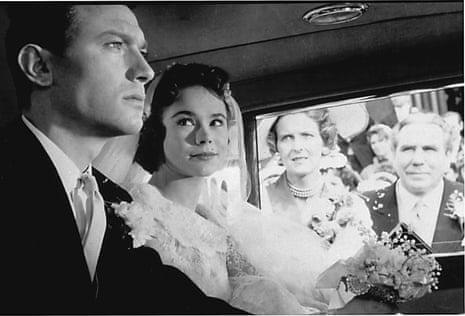“Joe … be gentle with me … ” It’s easy to imagine this demure invitation to premarital sex getting some ribald hooting in British cinemas in 1959. Jack Clayton’s multi-Oscar-winning film was adapted by Neil Paterson from John Braine’s moody, zeitgeisty bestseller, and it’s rereleased now with the traditional trigger warning about offensive and outdated attitudes. Now, that could mean pretty much everything about this film – but without doubt it is specifically aimed at Hermione Baddeley praising the hero’s manliness and grimacing: “Too many pansies about these days … ”
Room at the Top gave us Laurence Harvey as Joe Lampton, the smouldering, ambitious young working-class Yorkshireman with a chip on his shoulder and a burning desire to get on, and get laid. Achieving both, he calculates, could mean getting engaged to a rich young woman after (or during) the sowing of wild oats elsewhere to which he considers himself fully entitled. But he’s terrified of being tied down. So Joe is the poster boy for what no one in 1959 called toxic masculinity.
Joe travels from his modest home town of Dufton to the fleshpots of Warnley where he’s got a job in the town council’s accounts department. After impressing the typing pool with his good looks (including a simpering young secretary wonderfully played by Prunella Scales), he pals up with co-worker Charlie Soames (Donald Houston) who tells him about the fancy houses for posh people up the hill, the town’s “Top”; Charlie introduces him to the amateur dramatic society where he fatefully meets and falls for two separate women. One is the comely young Susan Brown (Heather Sears), daughter of the town’s plain-speaking plutocrat who is robustly played by Shakespearean legend Donald Wolfit. The other is the worldly, blowsy and sensationally sexy older woman Alice, unhappily married and played by Simone Signoret. (The character, English in John Braine’s novel, is now French.) Joe and Alice have an affair using the flat belonging to Alice’s friend Elspeth (Baddeley).
In truth, Signoret probably outclasses everyone in the movie with her charisma and address to the camera. But Harvey’s performance, though more effortful, still has vigour and style. This is an angry-young-man drama from the grimmer and more serious end of the spectrum; it is pretty humourless compared to John Boulting’s Lucky Jim (1957) or John Schlesinger’s Billy Liar (1963), which Room at the Top nevertheless resembles in its drama of class conflict and male frustration in a world where nice girls wouldn’t or if they did pregnancy was shatteringly immediate. In this it is closer to Karel Reisz’s Saturday Night and Sunday Morning (1960), whose hero also has a relationship with an older married woman, and Lindsay Anderson’s This Sporting Life (1963). Freddie Francis’s cinematography is extraordinarily good; he makes these country towns look pretty much as exciting as London or New York and he contrives some tremendous closeup compositions of people’s faces looming disturbingly out of the screen in foreground and background, years before Brian De Palma’s “split diopter” lens effects in movies like Carrie.
It’s certainly a film for the Talking Pictures TV audience, and it’s a pungent time capsule for postwar Britain where nasty snobbish remarks could be exchanged at the Rotary club. Maybe it’s not a masterpiece but it still packs a punch, and the scene at the end, where the audience overhears some awful news just before Joe does, is very powerful. Room at the Top certainly defined the life of author John Braine who wrote a sequel, Life at the Top (also filmed with Harvey, in 1965) and scripts for a continuing TV drama based on his athletic Lothario in an act of wishful-thinking autobiographical fiction which earned Braine the mockery of his contemporary and frenemy Kingsley Amis. Harvey himself would go on to make more of an impression in The Manchurian Candidate, but here he still looks like an old-school movie star.

Comments (…)
Sign in or create your Guardian account to join the discussion